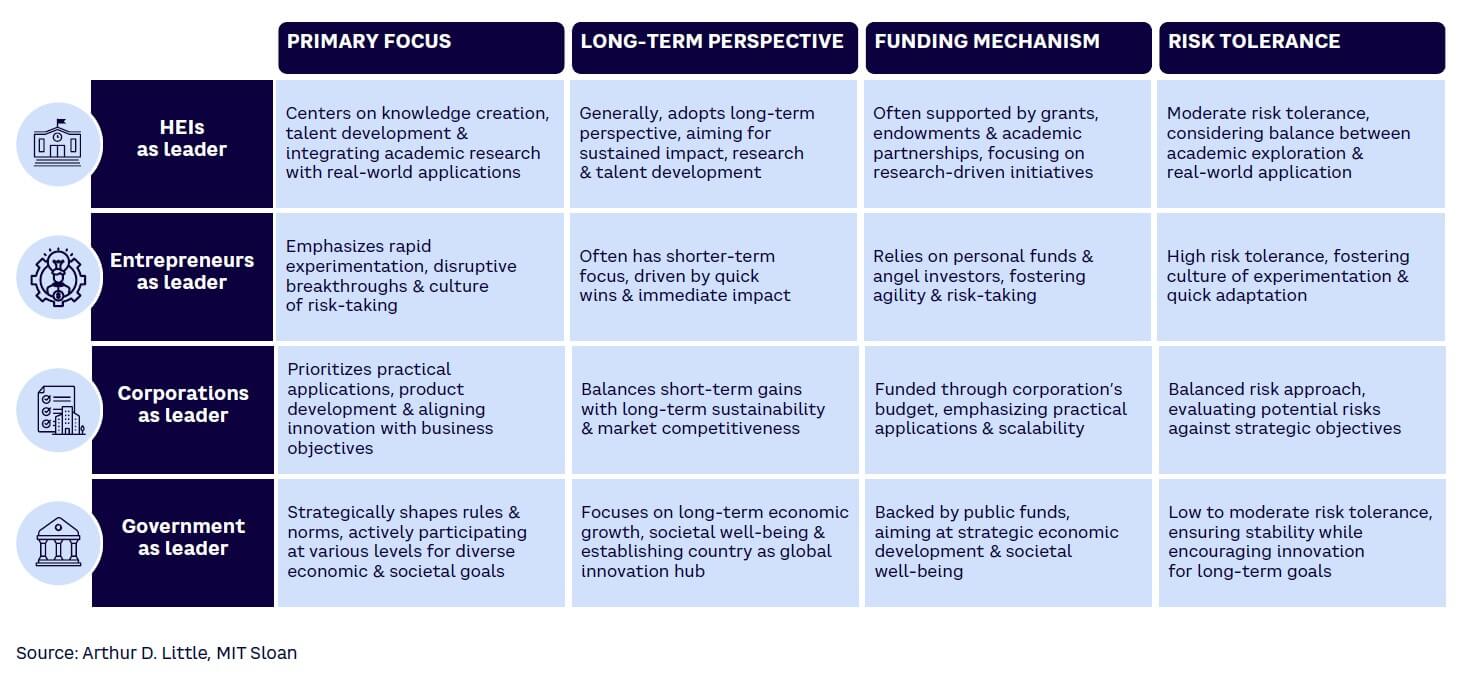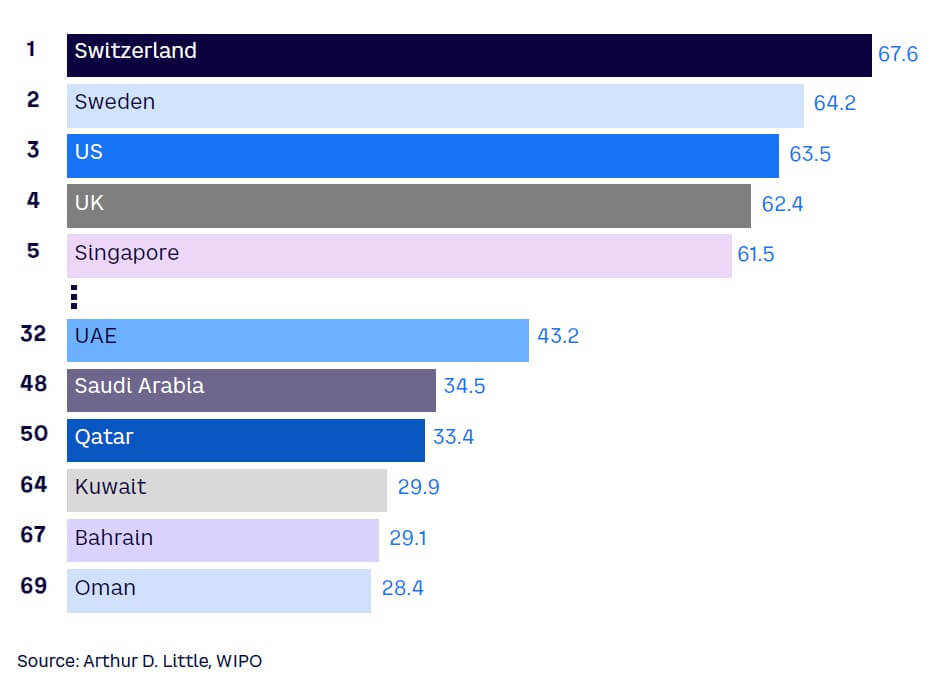
In an era of rapid technological evolution and increased global challenges, higher education institutions (HEIs) emerge as catalysts for development. This Viewpoint delves into the rising global interest in innovation hubs and discusses how HEI-led hubs can bolster national competitiveness and support the Kingdom of Saudi Arabia (KSA) Vision 2030 goals. After identifying untapped opportunities for such hubs to advance KSA’s innovation positioning, we articulate a number of key success factors for this to be realized.
ABOUT INNOVATION HUBS
Innovation hubs, as defined by Nature’s Global Innovation Hubs Index 2020, are cities or metropolitan areas designed to foster creativity, collaboration, and groundbreaking research. They bring together universities, R&D institutions, corporations, venture capital (VC) firms, incubators, and start-ups to achieve practical outcomes. In the Prism article “The Future of Innovation Districts,” Arthur D. Little (ADL) identified how such hubs “enable serendipity and foster innovation through the intensive co-location of different businesses and organizations” and noted that all stakeholders in a hub “benefit from a concentrated innovation ecosystem and supply chain in a single location.”
Globally, countries with a lot of research-focused HEIs are concentrating on developing innovation hubs led by universities. This approach acknowledges the pivotal role that HEIs play in advancing innovation and making significant strides in a nation’s global competitiveness, technological advancements, and sustainable development. Innovation hubs provide a complete value proposition by combining ideas, stakeholders, and resources. Their key objectives are to:
-
Accelerate R&D by speeding up the process of creating and implementing new ideas, products, and emerging technologies through focused initiatives that bring people and resources together. Innovation hubs conduct cutting-edge research that leads to scientific breakthroughs and technological advancements, provide state-of-the-art research facilities and equipment to support R&D, and collaborate with industry partners to address real-world challenges.
-
Foster collaboration, networking, and partnerships by creating an environment that facilitates idea exchange, encourages cooperation between diverse stakeholder groups (e.g., industry, government, academia) to tackle problems (through research centers, seminars, workshops, and conferences), and produces valuable partnerships within the innovation ecosystem.
-
Support entrepreneurship by providing essential resources such as courses/programs, mentorship, funding, and infrastructure (e.g., physical space, technological resources, R&D resources, policy development/reforms) to stakeholders. The notion of “corp-ups” also comes into play: corporations mentor start-ups and enable their development through networks and procurement channels not otherwise available to them.
-
Contribute to socioeconomic development by fostering innovation within specific sectors, attracting investments, and creating job opportunities in emerging industries. Innovation hubs democratize access to resources and opportunities, bridging socioeconomic gaps. They conduct research that informs public policy and decision-making, leading to evidence-based solutions for social and economic issues.
-
Promote knowledge transfer and skills development by facilitating knowledge sharing and skills enhancement through education programs, workshops, and initiatives that empower individuals and organizations. The hubs offer lifelong learning opportunities, facilitate technology transfer and commercialization of research findings, and provide experiential learning opportunities that allow students to gain practical skills and industry experience.
INNOVATION HUB LEADERSHIP MODELS
Successful innovation hubs comprise entrepreneurs, corporations, governments, and HEIs. Each stakeholder plays a unique role within the complex innovation ecosystem; the hub can be led by any of the primary stakeholders, thereby shaping the hub’s model. Although the models have similar objectives and all include some combination of the four stakeholders, key differences emerge based on leadership (see Figure 1).

HEIs as leader
Universities, with their global outlook and regional focus, have a long tradition of leading innovation hubs. Generally, HEIs see innovation hubs as a way of activating technology-transfer programs, empowering their leading researchers to become innovators. This brings in revenue, and its close alignment with blue-chip technology companies (and exciting start-ups) is a draw for students. Universities typically demonstrate a moderate amount of risk tolerance, striking a balance between academic exploration and real-world application. Their risk is substantially underwritten by public grants and government funds — hence the supporting role of government, with endowment capital usually spent on “safe” investments like property (sometimes to create an innovation hub). Innovation hubs led by HEIs would help a country address certain challenges, such as:
-
Funding allocation — inefficient allocation of funding in research, development, and innovation (RDI) areas
-
Research, development, and innovation — insufficient channeling of global trends and national ambitions into focused RDI efforts in priority sectors and fields to drive innovation levels and socioeconomic development (either directly through increased investments and added jobs, or indirectly through spillover effects into the economy)
-
Integration of academic research with industry — lack of adequate partnerships between industry and academia to translate core research into market-ready products
-
Talent development — insufficient levels of top talent (e.g., students and researchers) and inadequate upskilling of existing talent in labor force
-
Culture and mindset — legacy mindset in academia within HEIs focused on traditional learning and lacking adequate risk-taking culture
Innovation hubs led by HEIs can serve a clear purpose; however, close cooperation with other ecosystem stakeholders will help in achieving key objectives. For instance, working closely with the government will ensure the outputs of the innovation hub align with the national strategic direction, will streamline funding initiatives, and can support more innovative policy setting. Similarly, working closely with corporations will deliver real-world insights to the innovation hub and provide practical application to the corporations. It will also offer a channel for focused talent development. Finally, working closely with entrepreneurs facilitates an environment where personal funds and angel capital can promote rapid experimentation that leads to the type of disruptive breakthroughs that maximize shareholder value.
A prominent example of HEI-led innovation hubs is Kendall Square, located in Cambridge, Massachusetts, USA. Kendal Square was born out of neighboring MIT (Massachusetts Institute of Technology) in an area partly occupied by an abandoned industrial complex. It has since become one of the world’s most successful innovation hubs. MIT is known for industry partnerships and commercialization of the many ideas generated at the university. It is therefore well suited to its role as an anchor institution to Kendall Square, providing the knowledge component of the hub. This, in combination with a smart, targeted urban development plan through construction projects both architecturally attractive and well connected, provides a major draw to high-caliber talent and businesses. Among other things, Kendall Square has become a center for innovation in biopharmaceuticals and AI.
In the context of KSA, HEI-led innovation hubs will effectively contribute to the national strategic vision of becoming a diversified, knowledge-based economy. They will help spur economic growth, job creation, technological advancement, and societal development, leading to a more dynamic and innovative small and medium-sized enterprise (SME)/start-up sector, while positioning the Kingdom to thrive in a rapidly changing global landscape.
THE ROLE OF INNOVATION IN KSA’s ECONOMIC DEVELOPMENT
The World Intellectual Property Organization (WIPO) Global Innovation Index (GII), a holistic measure of innovation performance for nations worldwide, highlights Switzerland, Sweden, the US, the UK, and Singapore as leaders in global rankings. This can be attributed to sustained R&D investments coupled with a supportive environment for researchers. As nations acknowledge the pivotal role of innovation, the Kingdom has a unique opportunity to address socioeconomic challenges and carve out a niche in the global innovation ecosystem. It currently does not rank in the GII’s top 30, but KSA achieved significant advancements to now rank 48th globally and second among its Gulf Cooperation Council (GCC) peers (see Figure 2).

Saudi Arabia’s R&D expenditure has contributed to innovation in clean technology, last-mile delivery ventures, and various fintech solutions. Its current innovation landscape places a strong emphasis on digitalization and sustainable solutions. The digitalization focus includes e-commerce, financial services, education, healthcare, and manufacturing. KSA’s strong commitment to sustainable solutions is driving growth in clean energy, electric vehicles, waste management, and other environmentally friendly innovations.
According to the 2023 GII, the United Arab Emirates topped the GCC countries, with 1.5% of gross expenditure on R&D as a percentage of GDP, followed by Qatar at 0.7%. Saudi Arabia only recorded 0.5%. This highlights the need for the Kingdom to increase spending on R&D to drive economic contribution and align with its global and regional peers. KSA has already announced a target of SAR 60 billion (~US $16 billion) in R&D contribution to GDP by 2040, and by encouraging R&D investment, stakeholder collaboration, entrepreneurship/start-ups, and talent development, innovation hubs can play a significant role in enhancing KSA’s regional and global positioning.
HEIs CAN LEAD KSA’s INNOVATION POSITIONING
Innovation hubs can directly and indirectly contribute to the realization of the key strategic plans outlined in KSA’s Vision 2030, including sectoral development, labor market enhancement, skills development initiatives, energy transition, digital economy, and broader socioeconomic advancements. These objectives, cascading from pillar 2 (“A Thriving Economy”), include:
-
Nurturing and supporting an innovation and entrepreneurship culture
-
Developing promising local companies into regional and global leaders
-
Cultivating the digital economy
-
Attracting foreign direct investment
-
Increasing SME contribution to the economy
KSA has already demonstrated a keen focus on innovation, and investment in the HEI sector, particularly universities, has been increasing year over year. Many universities have dramatically improved performance on international ranking scales, largely thanks to the quality of university-led research. Many universities, operating independently but reporting to the Council of Universities’ Affairs, are looking to capitalize on their research activities and generate new revenue lines.
Many KSA universities have an internal entrepreneurship and innovation department. At King Abdullah University of Science and Technology (KAUST), the KAUST Innovation platform focuses on translating academic research into practical applications, fostering entrepreneurship, and contributing to the vibrant innovation ecosystem in Saudi Arabia through collaborations with industry and entrepreneurs. Innovation ecosystem programs delivered by the department include start-up activities, accelerator programs, an innovation VC fund, and an incubator.
Many KSA universities are building innovation hubs or larger districts to deliver on research translation goals and the “third mission” of higher education: public service. At King Fahd University of Petroleum and Minerals (KFUPM), the Dhahran Techno Valley (DTVC) is a hub for research and innovation in energy, sustainability, and related sectors, with a thriving mix of academia, local champions (e.g., Saudi Aramco and SABIC), and international technology leaders such as Baker Hughes.
Not all universities have the same level of research activity; institutions must be able to leverage various value propositions to support the development of an innovation hub. The two examples above are relatively small in the Saudi context (in terms of student numbers) and are examples of research-intensive institutions. Across the Kingdom, a range of other HEI models are starting to develop, which could include large comprehensive universities (with a mix of teaching and research activities) or more targeted teaching universities (with a focus on developing the workforce through high-quality undergraduate education).
Research-intensive institutions have a wide body of intellectual property that can underpin the development of an extensive innovation hub. A comprehensive university may develop an innovation hub based on a singular strength (a particular institutional mission or focus on research). A teaching university is more likely to act as a regional facilitator of innovation, leveraging undergraduates and easing the transition into the knowledge economy. This is a critical role, particularly in small KSA cities, which have not seen the same level of private investment as Riyadh, Jeddah, or Makkah.
HEI activities for innovation should also be seen in the context of other R&D initiatives in the Kingdom, which include setting up research and technology institutions like King Abdullah City for Atomic and Renewable Energy (K.A.CARE) and King Abdulaziz City for Science and Technology (KACST). The latter is a longstanding scientific council and research center that recently commissioned “The Garage,” an innovation district in the heart of Riyadh. K.A.CARE collaborates with universities to propel cutting-edge research in nuclear technology, renewable energy, and manufacturing localization.
Moving forward, as key entities like the Public Investment Fund (PIF) and the Ministry of Investment of Saudi Arabia (MISA) look to diversify KSA’s economy away from oil, these entities can play a crucial role in uncovering untapped opportunities within the innovation ecosystem. Notably, both entities have identified some common priority investment sectors, including aerospace and defense, automotive, transport and logistics, food and agriculture, construction and building components, entertainment, leisure and sports, financial services, real estate, utilities and renewables, metals and mining, healthcare, consumer goods and retail, and telecom, media, and technology. Universities — particularly those with lower levels of research — would be well served to prioritize some of these sectors in their research and innovation plans.
We see two tracks to crafting a comprehensive, sector-focused model for innovation in KSA. It can continue to build on its core competencies in traditional industries like oil and gas and leverage existing strengths, infrastructure, and expertise for further innovation within a sustainability and clean-energy premise. Alternatively, it can identify new focus areas driven by market-trend analysis and national priorities. In developing innovation hubs, HEIs must consider the appropriate track to take, in the context of local, regional, and national goals, as well as institutional strategic priorities (i.e., research versus teaching, industry focus versus sectoral focus).
KEY INNOVATION HUB SUCCESS FACTORS
As innovation hubs emerge as enablers of economic growth, it is essential to navigate the inherent challenges and embrace factors that ensure sustained success. Figure 3 shows the key success factors for innovation hubs in the evolving landscape of innovation and entrepreneurship.

Conclusion
KEY STEPS FOR INNOVATION HUB DEVELOPMENT
With the promise of innovation hubs as a potential key instrument for innovation and economic growth and diversity in KSA, their successful realization can be achieved through the following steps:
-
Assess existing innovation environment, university landscape, stakeholder ecosystem, and relevant national plans.
-
Engage with ecosystem stakeholders to document ambitions, gather insights, and form a collaborative environment.
-
Assess leading global innovation hubs to identify lessons for KSA’s innovation hub(s).
-
Define a strategic vision for the innovation hub(s), aligned with Vision 2030 and KSA’s RDI targets.
-
Design the operating model for the hub(s), including scope, strategic objectives, organizational framework, governance, regulations, talent requirements, infrastructure requirements, and enabling processes and tools.
-
Allocate financial and human resources to support the launch and ongoing operations of the hub(s), while maintaining flexibility to adapt to evolving trends.





